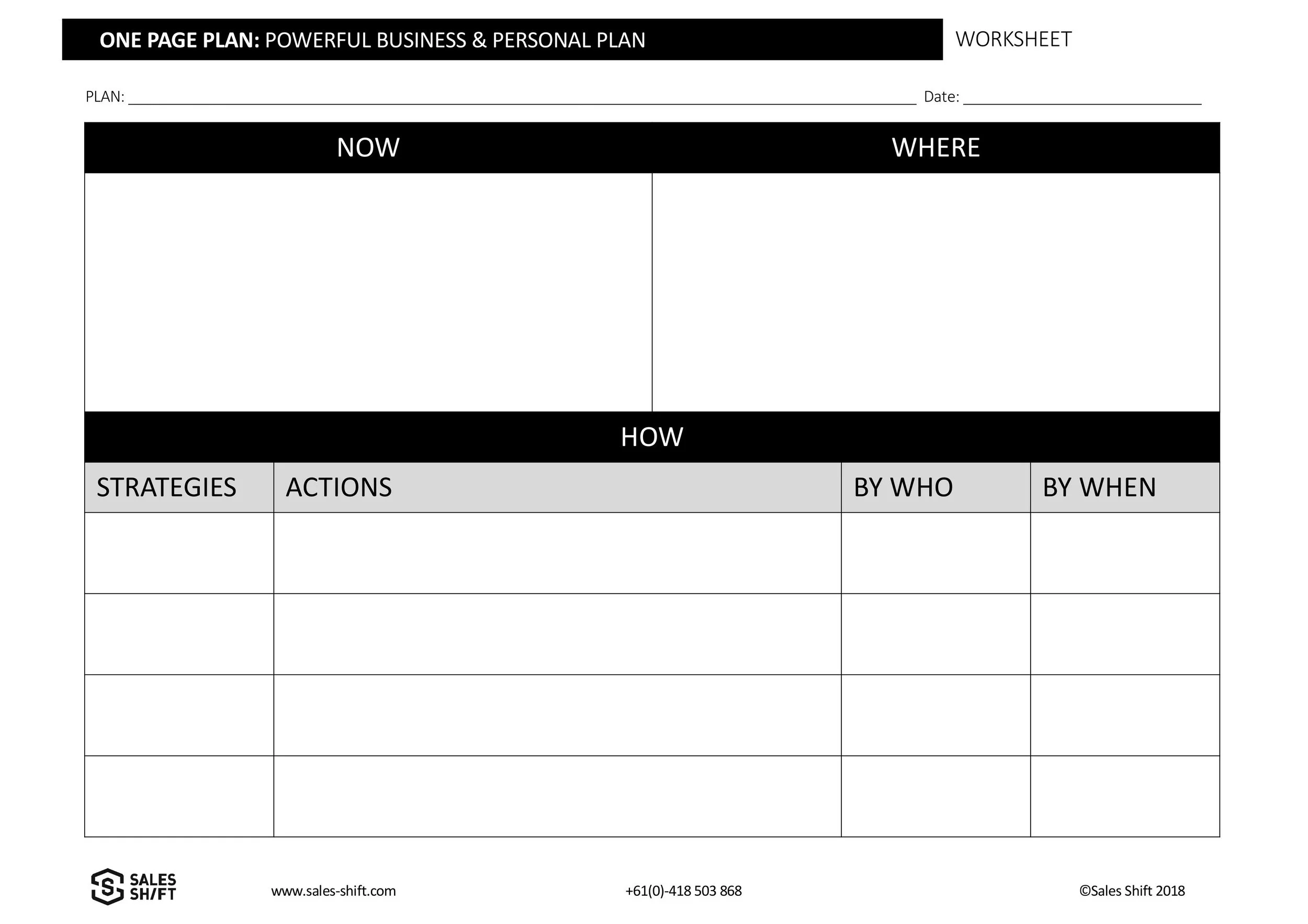
One Page Planning
The one page plan is a simple yet effective tool to develop a business or personal plan.
Using the Now, Where, How structure the one page plan shows where the organization, person, or issue is now, where it plans to be at some time in the future, and how it will get there. This ‘how’ analysis lists the strategies, action plans, responsibility and target timing for the key activities. The main advantage is the ease of completion and updating of the plan.
Why plan on one page?
It is a simple and practical way to record the steps and outcomes of any planning process.
The one page plan uses a Now-Where-How structure.
The top left corner of the plan is the ‘Now’ Analysis.
The top right is the ‘Where’ Analysis and the bottom half of the plan is the 'How' Analysis.
The bottom left of the plan has space for your 'Strategies', the center has space for your 'Action Plans' and 'Timing - who and when' are listed on the bottom right.
NOW Analysis
· where are you NOW?
· describe your current situation in bullet point form.
· you need a clear understanding of the key elements
· where are you NOW on the key issues such as sales, customers, products, and customers?
WHERE Analysis
· where would you like to be in the FUTURE on the Now issues?
· it may include elements of the Vision and Business Statement
· it can include the Sustainable Competitive Advantage, Key Performance Measures and Objectives
HOW Analysis
· these are strategies that will bridge the gap between the NOW and the WHERE
· the specific action plans are generated from these strategies.
· The timing and responsibility of the action plans are listed.
The advantages of the One Page Plan include: it takes only minutes to do, it can be updated just as quickly, it’s a control document for your business improvement process, it’s simple and easily understood by all stakeholders, your employees, your bank, your strategic partners (and yourself). Where a partner, such as a bank, needs more detail such as a market analysis or financial projections, these can easily be added by attaching them to the One Page Plan. It is essential that you date the plan and to update it on at least a bimonthly basis. It’s usually only the action plans that need changing in the short term.
Step by Step Guide
Step 1. Introduce the Now Where How concept. Stress that the benefits of a 'One Page Plan' are that it is a working plan which is continuously reviewed / revised and easy to communicate to team members (to get action and focus) as opposed to the traditional 100 page plan which rarely gets updated (as it is too much work).
Step 2. Draw up the one page format as shown below:
Step 3. Brainstorm the 'Now' analysis. Aim to develop about 7 or 8 key elements that summarize where the business is Now. Examples of the Now items are as follows:
Leading supplier in the market.
Poor profit performance over the last 3 years.
Over-reliance on two key customers.
Profitable UK operation that is growing at an annual rate of 20%..
Step 4. Brainstorm the 'Where' Analysis. Include Vision elements, the Sustainable Competitive Advantage (SCA) and Key Objectives. Examples of items are as follows:
Leading supplier to the tile industry in Georgia
We will win by having the fastest response time in the industry.
Launch two new products each year.
CEO replacement recruited by ...
Profit will be at least 10% NPBT.
Step 5. Develop strategies using tools such as Strategic SWOT, Competitor Analysis, and Product Portfolio Analysis to develop the strategies and specific action plans. Use the Pareto Analysis tool to focus on the three to four key strategies which will have the greatest impact on taking the organization from where it is NOW to WHERE it wants to be.
Step 6. Use Mindshop tools such as Force Field analysis and Five Whys to develop 3 to 4 key actions for each strategy. Make sure you specify a target date and a person responsible for each action item.
Step 7. Write a date on the plan and stress the importance of updating the action plans at least bimonthly.
Step 8. Ensure that there are three or four key performance measures that can be used to measure the plan results.


